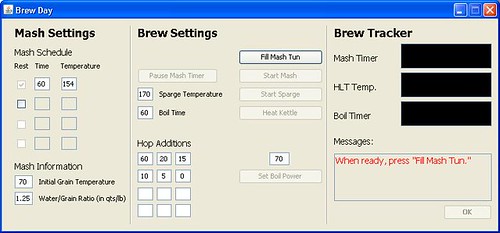utopeya
Active Member
So I've built a semi-automated cooler-based E-HERMS (based mostly on ideas stolen from these boards), and on my first mostly-successful brew day using my completed setup, I was slightly disappointed with my efficiency. So I thought I would go through my process, and someone might be able to tell me where I'm making a mistake.
I was doing a 6-gallon batch, grain bill just over 18 pounds. (19 counting the rice hulls--by the way, I added the rice hulls in dry; was that a mistake?) After making sure to stir everything really well, I set the pump to recirculate. My first rest was 122 (although I overshot by about 1-2 degrees) for 15 minutes. During this initial rest, I realized that my sparge arm had fallen from the cooler lid and that my pump was just shooting wort directly down into the grain bed. I fished the sparge arm out and put it back in place, and everything seemed to be fine.
When the 15 minutes were over, I ramped up to 149, which took about 40 minutes total. After letting the mash sit at 149 for an hour, I ramped up to 165 or so and then started sparging (at 170). After pumping sparge water in for maybe 12-15 minutes, I shut the pump off and let the wort continue draining into the kettle for another 15 minutes or so. When I had a little over 8 gallons (My kettle is wide, so my boiloff rate is high--and I was doing a 105-minute boil.), I stopped draining.
After boiling down to ~6 gallons, I had an OG of about 1.075. I was shooting for 1.090, which I would have gotten at 80% efficiency.
If you're still with me after that novel... what am I doing wrong? Did I sparge too fast? Did I recirculate too fast and cause channeling? Did I not mash for long enough? Any ideas would be appreciated.
As an aside: I wrote my own software to control my brewery using an Arduino. It's still a work in progress. (One day I'll automate the valves and figure out how to precisely monitor volumes and stuff.) It's a bit of a hack job, but if anyone's interested in this kind of system for an E-HERMS, you're welcome to the code. Just let me know...
Here's the control panel:

I was doing a 6-gallon batch, grain bill just over 18 pounds. (19 counting the rice hulls--by the way, I added the rice hulls in dry; was that a mistake?) After making sure to stir everything really well, I set the pump to recirculate. My first rest was 122 (although I overshot by about 1-2 degrees) for 15 minutes. During this initial rest, I realized that my sparge arm had fallen from the cooler lid and that my pump was just shooting wort directly down into the grain bed. I fished the sparge arm out and put it back in place, and everything seemed to be fine.
When the 15 minutes were over, I ramped up to 149, which took about 40 minutes total. After letting the mash sit at 149 for an hour, I ramped up to 165 or so and then started sparging (at 170). After pumping sparge water in for maybe 12-15 minutes, I shut the pump off and let the wort continue draining into the kettle for another 15 minutes or so. When I had a little over 8 gallons (My kettle is wide, so my boiloff rate is high--and I was doing a 105-minute boil.), I stopped draining.
After boiling down to ~6 gallons, I had an OG of about 1.075. I was shooting for 1.090, which I would have gotten at 80% efficiency.
If you're still with me after that novel... what am I doing wrong? Did I sparge too fast? Did I recirculate too fast and cause channeling? Did I not mash for long enough? Any ideas would be appreciated.
As an aside: I wrote my own software to control my brewery using an Arduino. It's still a work in progress. (One day I'll automate the valves and figure out how to precisely monitor volumes and stuff.) It's a bit of a hack job, but if anyone's interested in this kind of system for an E-HERMS, you're welcome to the code. Just let me know...
Here's the control panel:



